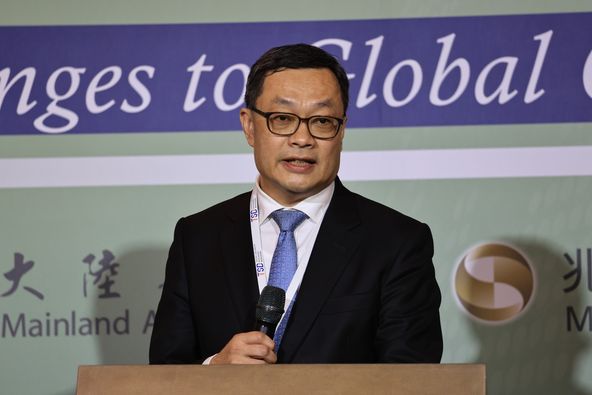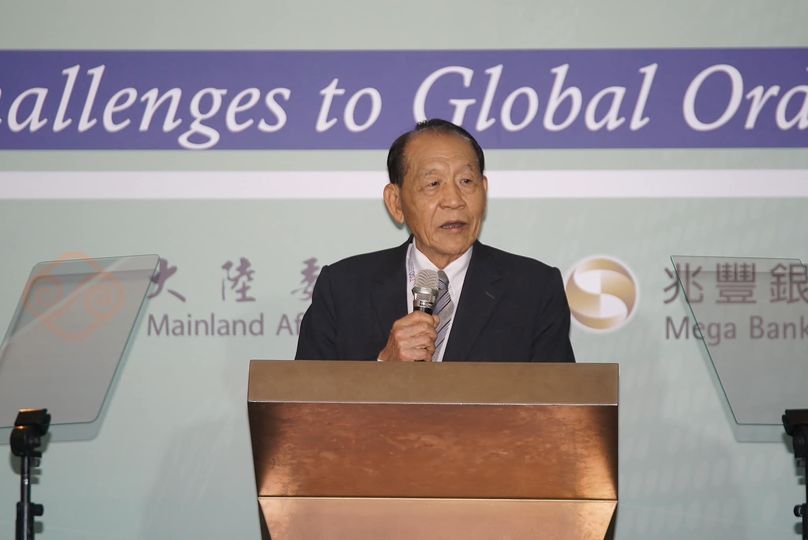Original text from: Seapower
BY EDWARD LUNDQUIST, SPECIAL CORRESPONDENT
Admiral Chen-Yeong Kang, a retired ROCN officer and member of the board of directors at NCSIST, quoted in the below article is a strategic advisor to INDSR. He was also formerly Deputy Minister of National Defense, ROC.
The People's Republic of China's (PRC) expanding political, economic and military might is casting a shadow over its regional neighbors in and around the South China Sea — a maritime thoroughfare that has global implications — and beyond. That is especially the case for the Republic of China (ROC), which is better known as Taiwan.
The PRC has steadily marginalized Taiwan in the international community. Today, just 17 countries still recognize Taiwan, although the PRC continues to pressure these smaller countries, with enticing offers of economic development. In 2018 the Dominican Republic and Burkina Faso became the latest to break ties with Taiwan and formally recognize the PRC.
But despite its isolation, Taiwan is a modern nation and still has many trading partners, with a very healthy economy and high standard of living.
The comparison between the two Chinas is stunning. The PRC's 1.26 billion people makes it the most populous country on Earth, and it is the third largest in area at 9.59 million square miles. Taiwan, by comparison, has about 22 million people living in an area of about 13,892 square miles — bigger than Belgium but smaller than Switzerland. And it lies just 100 miles away across the Taiwan Straits.
Both countries rely on the sea. The People's Republic relies on maritime commerce for energy from the Middle East and to deliver its exports to the world markets and has sought to control the trade routes passing through the South China Sea. The 1.4-million-square-mile sea has hundreds of small islands, reefs and atolls, which are variously claimed by one or more of the nations that border the sea. China has built upon some of those features to create artificial islands and unilaterally declared sovereignty over most of the South China Sea, despite internationally recognized boundaries of other nations. With the United States backing out of the Trans-Pacific Partnership and having a diminished role as the global leader, some see China as stepping forward to assume a larger global role. China is spreading beyond the South China Sea, to include the establishment of military bases in places like Djibouti and Pakistan.
But if the world should abandon Taiwan altogether, it might do so at its grave peril, as Taiwan and its strategic location represents the first obstacle in the way of Chinese expansionism.
Modernizing Capability With Domestic Industry
To defend itself, Taiwan is upgrading its military capabilities.
Taiwan used to have a large number of World War II-era U.S. Navy ships. Even today, Taiwan's fleet has several former U.S. ships that are a challenge to maintain. For example, the oceangoing fleet tug RCS Ta-Han (ATF 553) was originally the USS Tawakoni (ATF 114) and was turned over to Taiwan’s navy in 1978 when it was already 34 years old. The Ta-Han is still in active service and will be 75 years old this year. The ship’s World War II-era fathometer and gyro are still in use, yet it still operates and looks as good, if not better, then it did when it was transferred to Taiwan 40 years ago. Most of Taiwan’s ships are newer. In many cases the ROCN has updated older platforms such as its Knox-class frigates with new weapons and systems.
Taiwan is still able to procure new weapons and hardware from friendly nations, including the U.S. But owing to its unique status, many nations have imposed restrictions on selling military materiel to Taiwan.
But to a growing degree, the nation is relying on its indigenous capability. Much of that is designed, developed and produced by Taiwan’s National Chung-Shan Institute of Science and Technology (NCSIST) and its industry partners.
Founded in 1969, NCSIST has been the primary weapons systems provider for the ROC Ministry of Defense (MND). Today, NCSIST employs about 10,000 people and has formed joint venture companies with the private sector, serving to create a bridge between defense and industry.
As its name implies, NCSIST is engaged in science and technology (S&T) as well as research and development (R&D) and test and evaluation (T&E) — from product development and manufacturing to total life cycle sustainment and maintenance of systems. “We are involved in top-level requirements all the way on down to delivery,” said Adm. Chen-Yeong Kang, a retired ROCN officer and member of the board of directors at NCSIST.
When updating its fleet of aging U.S. destroyers several decades ago, NCSIST developed a replacement combat management system based on open-architecture principles and commercially available components. That investment has paid off, as the Modular Combat System (MCS) became the basic combat management system for the ROCN, and NCSIST leveraged that architecture onto all its subsequent platforms — from logistics ships and minehunters to frigates and destroyers.
Taiwan built eight Oliver Hazard Perry-class FFGs under license and recently acquired two more from the U.S. under Foreign Military Sales (FMS). But the SM-1 missile and MK13 launcher were eliminated from the U.S. FFGs long before the last was one was retired from the U.S. Navy in 2015. With a system that was no longer supported by the U.S., Taiwan — through NCSIST — developed its own capability to sustain those missiles.
The ROCN has several French Lafayette-class frigates as well as two former submarines from the Netherlands. Taiwan’s largest combatants are the four 9,700-ton Kee Lung-class guided-missile destroyers, which were transferred from the U.S., where they represented the Kidd-class guided missile variant of the Spruance-class destroyer. These are quite capable ships, equipped with NTDS (Navy Tactical Data Systems), NTU (New Threat Upgrade) and the SM-2 missile, but they are sustained and kept combat-relevant thanks to NCSIST.
Taiwan’s policy moving forward is to build capability domestically. Some high-end technology still must be imported, such as fighter jets, but the ROC’s domestic industry is or will be building new ships, submarines and even supersonic missiles.

The Washington-based Global Taiwan Institute (GTI) issued a report stating that Taiwan can fulfill half of its future defense equipment requirements on its own but must rely on international cooperation for the other half. While Taiwan can build state-of-the-art platforms, it may need to rely on foreign-made components, such as gyros for guidance systems, the GTI report said.
A new 10,000-ton assault ship will have a networked command center and the ability to carry aircraft, Marines and landing craft in its well deck as well as a fully equipped hospital and vehicles to support humanitarian assistance/disaster relief efforts. Taiwan International Shipbuilding Corp. (CSBC) is building its own LPD, or amphibious transport dock landing ship, which is scheduled to enter service in 2021.
The 40-knot, 600-ton Tuo Chang-class coastal patrol missile corvettes are the new face of the ROCN's surface fleet. Fast, heavily armed and stealthy, these all-composite catamarans carry a 76 mm gun, both the indigenous Hsiung Feng II subsonic anti-ship missile and Hsiung Feng III supersonic anti-ship missile, Phalanx CIWS and Mark 32 triple torpedo launchers. The first two are complete and the program is entering full production, with Lung Teh Shipbuilding selected to build the ships.
Chinese Opposition
The PRC's Foreign Ministry has emphatically stated the Chinese opposition to arms sales and defense technology transfers to Taiwan by the United States and other countries. The PRC also has complained about the presence of U.S. and allied ships in what Beijing considers to be a Chinese lake and passing near its newly created islands as “freedom of navigation operations” (FONOPS) are conducted.
For example, HMS Albion, a 22,000-ton amphibious warship, conducted FONOPS as it passed near the Paracel Islands last September. A People's Liberation Army Navy ship challenged the presence of USS Decatur during FONOPS near Gaven Reef and nearly ran into the American warship. More recently, in January, USS McCampbell conducted FONOPS “to challenge excessive maritime claims” and transited the Taiwan Straits with USNS Walter S. Diehl. In February, USS Spruance and USS Preble sailed by Mischief Reef.
In remarks in January at the Brookings Institution, Chief of Naval Operations Adm. John Richardson stated clearly the U.S. has a right to be there, adding that the Taiwan Strait is international waters.
“In global diplomacy, the word ‘sovereign’ is one all players need to recognize and understand,” said retired Rear Adm. Jim Shannon, a former deputy assistant secretary of the Navy, international programs. “For example, in FMS cases, countries choose what they are willing to sell or buy. That is a sovereign choice. It is one of several international norms and standards that all countries should recognize.”

China’s Ambitions
China has expanded its influence with developing nations around the world by buying up water, minerals and fishing rights; building railroads and factories; and, on its own, selling military equipment at prices that undercut the major defense suppliers. The deals seem too good to be true.
China has invested in port infrastructure improvement in several countries to help with the economic development of those nations. But the work has been largely done by Chinese companies with Chinese workers, and the recipient countries are often saddled with crushing debt.
Sri Lanka reportedly pays about 80 percent of its revenue to pay off the debt on underused Chinese-built facilities such as highways, ports and air terminals. In the case of Sri Lanka's port of Hambantota, Sri Lanka's government had to cede a major equity position in the project because it couldn’t pay off the loans.
According to Bob Hein, a retired Navy captain and now a defense and strategy analyst, some countries are turning down the Chinese aid packages because they can’t afford the strings attached.
Last August, Malaysian Prime Minister Mahathir Mohamad said his government was backing out of two major projects with China, including a rail line and a gas pipeline, in part because of concerns over the debt that would be incurred and the obligations that would come with such a deal.
Much has been said about China's centralized economy and its ability to take a patient approach to economic development. But the Communist Party leadership also is worried about any perceived internal threats to the continuity of the regime. “China's rising economy has also resulted in a rising plurality, and that worries the party leadership,” Hein said. “As much as China spends on defense, they spend even more on internal security. The biggest fear is what goes on domestically.”
Demographics are slowing economic growth, and Hein said that could preoccupy Beijing from military adventurism.
Hein said China's “one child” system (since liberalized) has resulted in their population becoming unsustainable, and the resulting declining population is also leveling off economic growth. An added dimension is the imbalance between the work force and the number of retirees. What used to be a ratio of four people to take care of one retiree will soon change to two to one.
“With so many older people to care for, and so few younger people to take care of them, this will become a huge drain on resources of the state,” Hein said.
And China knows that any major conflict it sparks would serve to disrupt its own economy most of all.
“China won't start a war they can't win,” Hein said. “That's why they haven't tried so far.”
Edward Lundquist traveled to Taiwan to visit the National Chung Shan Institute of Science and Technology to report on this story. He also went aboard RCS Ta-Han (ATF 114) in Keelung. Lundquist served aboard that ship when it was USS Tawakoni (ATF 114) 40 years earlier.




